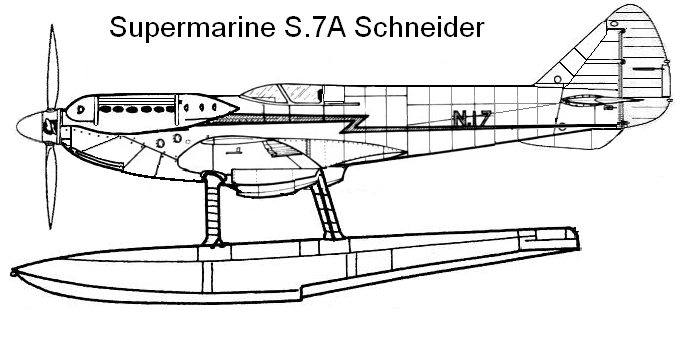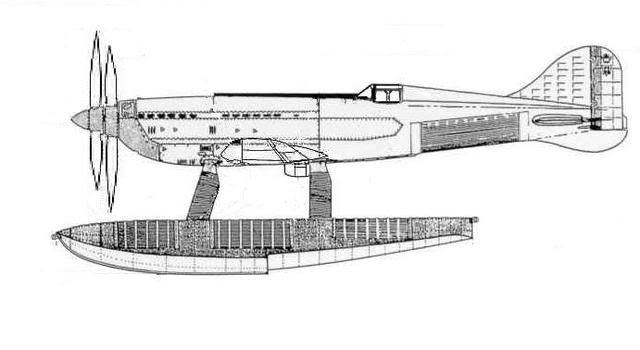The RAF High Speed Flight will be attending with two Supermarine S.7b flown by Henry Waghorn and John Boothman.
The ailing R.J. Mitchell has refined the S.7 further this year with some aerodynamic improvements but mainly hopes are pinned on the RR 'R' III with its ethanol/ petrol mixture and now producing nearly 3,000hp.

(S.7b almost idenitcal)
Aircraft Type or Name:
Supermarine S.7b Schneider
General Type:
Airplane = 1
Airship = 2
Orbiter = 3
1
Year of First Flight: 1937
Description
Flying Boat / Seaplane
Monoplane
Conventional Fuselage
A Schneider Trophy racing seaplane designed by R.J. Mitchell. Powered by RR 'R' III V-12 with ethanol additive fuel. Evap cooling on starboard wing and three ventral radiators.
Characteristics:
Weight (maximum) 6,250 lbs
Weight (empty) 5,310 lbs
Length 31.8 ft
Wingspan 35 ft
Wing Area 200 sq ft
Sweep 2 degrees
Engines 1
Rolls-Royce 'R' III
Piston
2,860 hp
Crew 1
Typical cost $0.351 million in 1937
Total number procured 3
Performance:
Top Speed 383 kts = 440 mph
at 0 ft
Mach N/A
Operational Ceiling 27,500 ft
Range 180 nm = 207 miles
with 32 lbs payload
34 lbs released at halfway point
Climb 7,185 fpm
Cruise 355 kts = 408 mph
at 0 ft
Corner Speed 184 KIAS =
184 kts at 0 ft
Mach N/A
Turning Rate 21.6 deg/sec
Radius 1,655 ft
Internal Data:
Intake / Fan Diameter 11 ft
Bypass Ratio 49.72
Engine Weight 1990 lbs
Overall Efficiency 17 percent
Structural Factor 1.00
Number of Wings 1
Number of Fuselages 1
Limiting Airspeed 450 kts
Wing Ultimate g Load 6.00 g
Wing Taper 0.2
Wing Thickness at Root 1 ft
Tail / Canard Factor 0.3
Number of Nacelles 2
Length 24.5 ft
Diameter 1.75 ft
Fullness 0.3
Fuselage Diameter 3.85 ft
Fuselage Fullness 0.4
Pressurized Volume 0 percent
Cargo Decks 0
Cleanness 72 percent
Unstreamlined section 1 sq ft
User equipment 50 lbs
Gloster will also enter an aircraft. Henry Folland and his team have designed an aircraft remarkably similar to the S.7 but with a smaller wing and much lighter weight. It is also powered by an 'R' III engine thanks to the donation of the engine by Rolls-Royce who have built eight 'R' III engines this year. The Gloster VII will be flown by an unknown flyer, Alex Henshaw.
Aircraft Type or Name:
Gloster VII
General Type:
Airplane = 1
Airship = 2
Orbiter = 3
1
Year of First Flight: 1937
Description
Flying Boat / Seaplane
Monoplane
Conventional Fuselage
A Schneider Trophy racing seaplane powered by an RR 'R' III V-12 with ethanol additive fuel. Evaporative cooling on both wings and two ventral radiators and two oil coolers.
Characteristics:
Weight (maximum) 5,400 lbs
Weight (empty) 4,453 lbs
Length 29 ft
Wingspan 28 ft
Wing Area 115 sq ft
Sweep 1 degrees
Engines 1
Rolls-Royce 'R' III
Piston
2,860 hp
Crew 1
Typical cost $0.407 million in 1937
Total number procured 2
Performance:
Top Speed 419 kts = 482 mph
at 0 ft
Mach N/A
Operational Ceiling 35,500 ft
Range 180 nm = 207 miles
with 175 lbs payload
184 lbs released at halfway point
Climb 8,503 fpm
Cruise 355 kts = 408 mph
at 0 ft
Corner Speed 223 KIAS =
223 kts at 0 ft
Mach N/A
Turning Rate 17.8 deg/sec
Radius 2,425 ft
Internal Data:
Intake / Fan Diameter 11 ft
Bypass Ratio 49.72
Engine Weight 1990 lbs
Overall Efficiency 17 percent
Structural Factor 1.00
Number of Wings 1
Number of Fuselages 1
Limiting Airspeed 450 kts
Wing Ultimate g Load 6.00 g
Wing Taper 0.1
Wing Thickness at Root 1 ft
Tail / Canard Factor 0.35
Number of Nacelles 1.5
Length 25.2 ft
Diameter 1.7 ft
Fullness 0.3
Fuselage Diameter 3.75 ft
Fuselage Fullness 0.4
Pressurized Volume 0 percent
Cargo Decks 0
Cleanness 75 percent
Unstreamlined section 1.2 sq ft
User equipment 50 lbs


Quoted
Originally posted by ALVAMA
Quoted
Originally posted by Hood.
Quoted
Originally posted by Hrolf Hakonson


